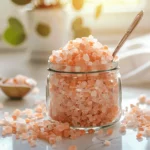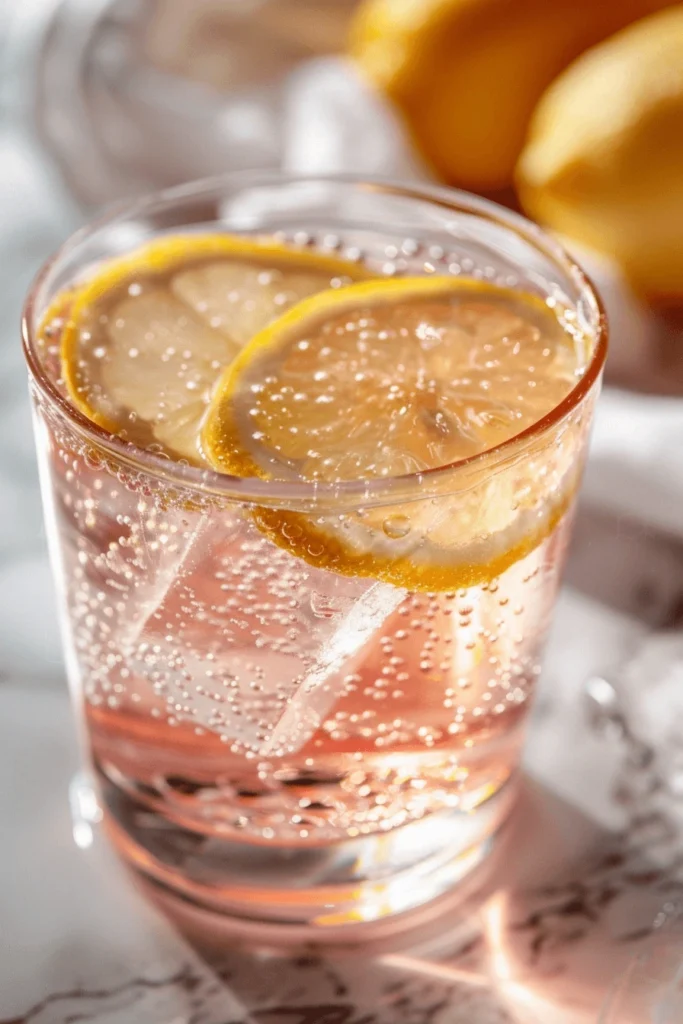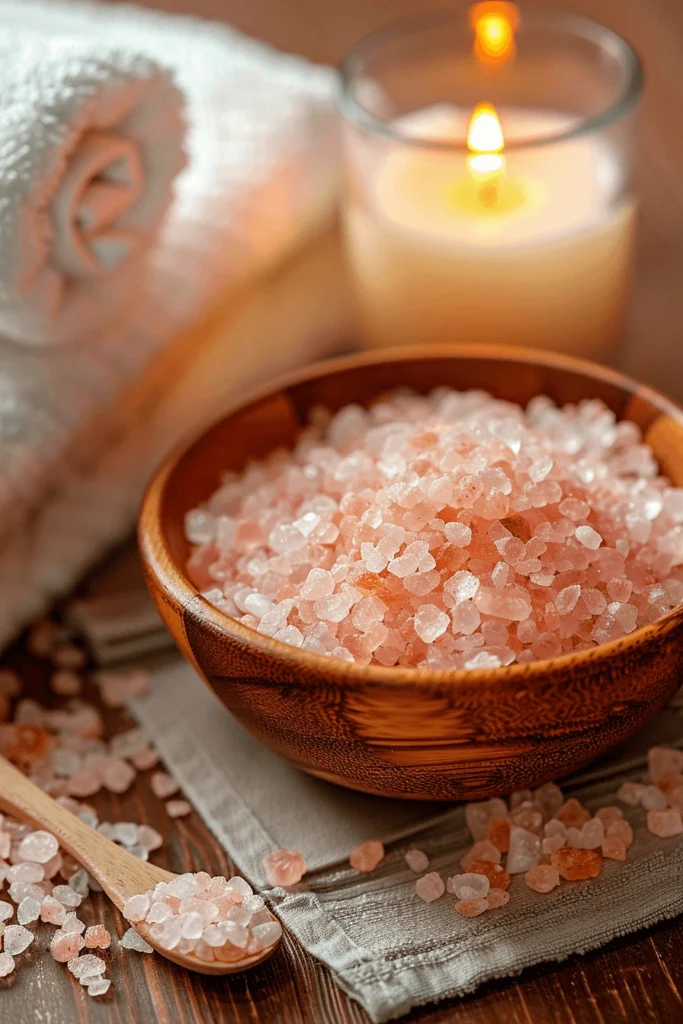Salt usually gets a bad rap — we’ve all heard someone say, “Cut back on salt if you want to stay healthy.” But here’s the twist: not all salts are created equal. Enter the Japanese pink salt recipe, a fascinating blend that wellness enthusiasts are calling a game-changer for detox, hydration, and even weight loss. Picture this: a pinch of beautiful rosy crystals swirling into water, turning your plain glass into a mineral-rich wellness tonic. It’s like giving your body a spa day — minus the cucumber slices on your eyes. This article will break down how Japanese pink salt is used, why it works, the science behind it, and exactly how you can incorporate it into your daily routine without overdoing it. So, let’s get salty — in the healthiest way possible.
Print
Japanese Pink Salt Recipe
- Total Time: 5 minutes
Ingredients
1 teaspoon Japanese pink salt
1 cup filtered water
Optional: lemon juice, honey, or mint
Instructions
Add pink salt to a glass jar with water.
Stir or let it dissolve overnight.
Mix 1–2 tbsp of the solution into a full glass of water before drinking.
- Prep Time: 5 minutes
Nutrition
- Serving Size: 1 glass
Table of Contents
Understanding the Japanese Pink Salt Recipe
What is Japanese Pink Salt?
At first glance, Japanese pink salt looks like something you’d want to sprinkle on sushi for the aesthetic alone. Its rosy hue isn’t just for show — it comes from trace minerals like iron, magnesium, and potassium. These little extras are what set pink salt apart from regular table salt. When people talk about the Japanese pink salt recipe, they’re usually referring to a mineral-infused drink made by dissolving pink salt in water to create a natural electrolyte solution. Think of it as the opposite of sugary sports drinks — it’s salty, yes, but in a way that fuels your body with essential nutrients rather than artificial additives.
Origins and Cultural Significance in Japan
In Japan, salt isn’t merely seasoning; it’s part of tradition, ritual, and even spirituality. Temples often use salt to purify spaces, while Japanese kitchens have relied on mineral-rich salts for centuries. The Japanese pink salt recipe borrows from this cultural reverence, blending ancient practices with modern wellness trends. While Himalayan salt hogs the spotlight in the West, Japan’s pink salt traditions remind us that this mineral has always been more than just a table shaker — it’s a link between health, ritual, and daily life.
How It Compares to Himalayan Pink Salt
Now, you may be wondering: isn’t this the same as Himalayan pink salt? Not quite. Himalayan salt comes from Pakistan’s famous Khewra mines, while Japanese pink salt has different mineral ratios and distinct processing methods that give it unique flavor notes. Nutritionally, both varieties are richer than refined white salt, but Japanese pink salt often carries a milder, cleaner taste that pairs beautifully with delicate Japanese dishes like sashimi or broth. When used in the Japanese pink salt recipe, it dissolves smoothly, making it easier on the palate compared to its Himalayan cousin.
Nutritional Profile and Trace Minerals in Pink Salt
Here’s where things get interesting. A teaspoon of Japanese pink salt is more than just sodium — it’s like a compact multivitamin from nature. Common minerals include:
| Mineral | Benefit for Body |
|---|---|
| Sodium | Balances fluids, supports nerve function |
| Magnesium | Relaxes muscles, reduces stress |
| Potassium | Maintains heart health, prevents cramps |
| Iron | Boosts energy and blood production |
| Calcium | Strengthens bones and teeth |
Health Benefits of Japanese Pink Salt Recipe
Why It’s Gaining Popularity in Weight Loss Diets
The Japanese pink salt recipe has made waves among health-conscious folks and weight loss enthusiasts alike. Why? Because it offers a simple way to stay hydrated and nourished without sugar-laden drinks or processed powders. When you dissolve pink salt into water, you’re essentially creating a natural electrolyte tonic. This can help regulate fluid balance, reduce bloating, and support metabolism — three big factors in sustainable weight loss. Unlike crash diets that leave you cranky and sluggish, this mineral-rich drink helps the body burn fat more efficiently while keeping your energy steady.

Role in Hydration and Mineral Balance
One of the biggest reasons the Japanese pink salt recipe works so well is its effect on hydration. Regular water is good, but water with a pinch of pink salt becomes great. The trace minerals in the salt act like tiny keys that unlock better absorption in your cells. That means when you drink salted water, your body holds on to hydration longer instead of flushing it out immediately. This can be especially helpful for athletes, people working outdoors, or anyone who struggles with fatigue from dehydration. Think of it as giving your water a superpower upgrade.
Detoxification Properties and Gut Health Support
Here’s another reason people rave about the Japanese pink salt recipe: it gently supports detoxification. Pink salt water can encourage healthy bowel movements by stimulating digestive enzymes and balancing stomach acid. In fact, many wellness practitioners recommend drinking it first thing in the morning to “wake up” the gut and flush out overnight waste. On top of that, the mineral balance supports a healthy microbiome — the friendly bacteria that play a major role in digestion, immunity, and even mood. A clean gut means better nutrient absorption, which translates to more energy and improved metabolism throughout the day.
For a nourishing side that complements the Japanese pink salt recipe, try baking this cottage cheese bread recipe packed with protein and gut-friendly goodness.
How to Prepare Japanese Pink Salt Recipe at Home
Step-by-Step Method for Beginners
Making the Japanese pink salt recipe couldn’t be easier. No fancy equipment, no hours in the kitchen — just water, pink salt, and a glass. Here’s the simple process:
- Take a clean glass jar with a lid.
- Fill it with about one cup of filtered water.
- Add 1 teaspoon of Japanese pink salt.
- Stir well, or let it sit overnight for the minerals to dissolve fully.
- Drink 1–2 tablespoons of the solution mixed into a full glass of water.
This mixture is sometimes referred to as a sole water solution. The idea is not to gulp down salty water but to create a mineral concentrate you can dilute into your daily drinking water.
Best Ratios of Pink Salt to Water
The golden rule for a balanced Japanese pink salt recipe is moderation. Too little salt won’t give you the mineral boost, while too much may overwhelm your taste buds (and your kidneys). For most people, ½ to 1 teaspoon of pink salt in 8–10 ounces of water is ideal. That amount gives you just enough electrolytes without making it taste like ocean water. Always start small and adjust according to your body’s tolerance.
Tips to Enhance Flavor and Absorption
Some people find the salty taste a little flat at first. Good news: you can boost both the flavor and the benefits with natural add-ins. Here are a few ideas:
- Lemon juice: Adds vitamin C and improves detox effects.
- Honey: Provides natural sweetness and extra energy.
- Mint leaves: Refreshing twist that aids digestion.
- Cucumber slices: Perfect for a cooling, spa-like drink.
Adding these ingredients not only makes the Japanese pink salt recipe more enjoyable but also helps the body absorb minerals more effectively. For example, pairing salt water with lemon can improve alkaline balance and hydration even further.
Japanese Pink Salt Recipe for Weight Loss
How Salt Water Impacts Metabolism
One of the most intriguing aspects of the Japanese pink salt recipe is its effect on metabolism. Unlike processed salt, which can lead to bloating and water retention, pink salt’s balanced minerals actually help regulate fluids and support metabolic activity. By improving hydration at the cellular level, it allows your body to burn calories more efficiently. Better hydration also means better oxygen flow, which fuels your muscles and keeps your metabolism humming throughout the day.
Morning Salt Water Routine for Fat Burn
If you’ve ever heard someone swear by drinking salt water first thing in the morning, they’re likely talking about the pink salt trick. Here’s why it works: when you drink the Japanese pink salt recipe on an empty stomach, it activates the digestive system, balances stomach acids, and stimulates metabolism. This “wake-up call” helps the body shift into fat-burning mode early in the day. Many people notice reduced cravings and improved energy levels, which makes sticking to a clean eating plan much easier.
For a simple morning routine:
- Mix 1 teaspoon of Japanese pink salt into 8 ounces of warm water.
- Add a squeeze of fresh lemon for an extra metabolic boost.
- Drink slowly before breakfast to kickstart your day.
Pairing with Exercise and Clean Eating
Of course, no recipe is a magic bullet — but when paired with healthy habits, the Japanese pink salt recipe becomes a powerful ally. Drinking mineral-infused water before workouts keeps you hydrated and replenishes electrolytes, preventing fatigue and cramps. It also curbs the urge to over-snack after exercise by stabilizing hunger signals. Combine this with a diet rich in whole foods — think lean proteins, fresh veggies, and whole grains — and you’ll create a balanced environment for weight loss.

Pro tip: Replace sugary sports drinks with diluted pink salt water during workouts. Not only will it save you empty calories, but it’ll also deliver real minerals your body can use.
If you’re focusing on clean eating alongside the Japanese pink salt recipe, a burger bowl recipe makes a perfect low-carb, high-protein option.
Other Uses of Japanese Pink Salt Recipe Beyond Weight Loss
Benefits for Skin and Beauty
The Japanese pink salt recipe isn’t only for drinking — it’s also a natural beauty booster. Pink salt water can be used as a skin toner, helping to balance oil production and minimize breakouts. Thanks to its antibacterial properties, rinsing your face with diluted pink salt water can reduce acne-causing bacteria while keeping your skin hydrated. For a DIY spa treatment, many people add pink salt to warm baths. The minerals soak into the skin, promoting relaxation, improving circulation, and leaving skin soft and refreshed.
Use in Cooking and Seasoning
Of course, the traditional role of pink salt is in the kitchen. Japanese chefs prize mineral-rich salts for their subtle flavors, which enhance delicate dishes without overpowering them. Sprinkling Japanese pink salt over grilled fish, steamed vegetables, or rice adds depth and a hint of natural sweetness. Compared to regular table salt, it offers a cleaner, less “sharp” taste that complements simple, whole foods beautifully. Incorporating small amounts of the Japanese pink salt recipe into meals can be a delicious way to reap health benefits while elevating everyday dishes.

Salt Baths and Relaxation Therapy
If sipping salt water isn’t your style, here’s another approach: salt baths. Adding a cup of Japanese pink salt to warm bathwater creates a soothing mineral soak. The magnesium in the salt helps relax tense muscles, while potassium supports better circulation. Many people find salt baths helpful for easing stress, reducing inflammation, and even improving sleep quality. It’s like having a personal hot spring experience right in your bathroom. This broader use of the Japanese pink salt recipe highlights its versatility — it’s not just a health drink, but a holistic wellness tool.
Side Effects and Precautions
Who Should Avoid Japanese Pink Salt Recipe?
As beneficial as it sounds, the Japanese pink salt recipe isn’t for everyone. People with high blood pressure, kidney disease, or heart conditions should be cautious, since even natural salt still raises sodium levels in the body. Pregnant women and children should also consult a healthcare professional before trying it regularly. While pink salt carries extra minerals, it’s not a free pass to ignore sodium sensitivity.
Risks of Overconsumption
The old saying “too much of a good thing” applies here. Overloading on pink salt water can lead to bloating, nausea, or electrolyte imbalances. In extreme cases, too much sodium may cause dehydration instead of preventing it — the exact opposite of what the recipe is meant to do. Drinking salty water in large amounts may also upset the stomach, leading to discomfort or diarrhea. Moderation is the key.
Safe Daily Limits and Recommendations
So how much is safe? Most experts recommend no more than one teaspoon of Japanese pink salt per day, dissolved and diluted in water. A good rule of thumb is to start with small amounts and monitor how your body reacts. If you’re drinking the recipe daily, balance your sodium intake by reducing processed foods, which often hide excessive salt. When prepared correctly, the Japanese pink salt recipe can complement a healthy lifestyle without tipping your sodium balance over the edge.
Expert Opinions and Scientific Studies
What Nutritionists Say About Pink Salt
Nutrition experts often remind us that while pink salt contains beneficial minerals, it’s still salt at the end of the day. Many dietitians suggest that the Japanese pink salt recipe can be a helpful hydration tool, especially compared to sugary energy drinks. However, they also stress moderation. According to nutritionists, the added trace minerals like magnesium and potassium are useful for balancing electrolytes, but they shouldn’t replace nutrient-rich whole foods. Instead, the recipe should be seen as a supportive wellness habit, not a miracle cure.
Scientific Research on Pink Salt Water
While formal studies on the Japanese variety are limited, there’s growing research on pink salt and its effects on hydration and digestion. Studies show that mineral-rich salts may help improve electrolyte absorption and support acid-alkaline balance in the stomach. Some evidence suggests that consuming a properly prepared pink salt solution can enhance gut health by stimulating digestive enzymes. That said, researchers agree that more clinical trials are needed to confirm claims of weight loss and detox benefits tied to the Japanese pink salt recipe.
Comparing Anecdotal vs. Evidence-Based Claims
On one side, countless wellness enthusiasts swear by drinking pink salt water daily. They report more energy, fewer cravings, better digestion, and even clearer skin. On the other side, scientists caution that many of these benefits could be explained by improved hydration and cleaner diets rather than the salt itself. The truth likely lies somewhere in between. Anecdotal evidence shouldn’t be dismissed — after all, traditions often carry wisdom — but pairing it with science gives a fuller, balanced picture. In other words, the Japanese pink salt recipe is promising, but it works best when combined with proven healthy habits like exercise and nutrient-dense eating.
FAQs on Japanese Pink Salt Recipe
Who should not use Himalayan pink salt?
While Himalayan and Japanese pink salts are rich in minerals, people with high blood pressure, kidney issues, or heart disease should avoid consuming them regularly. Both salts still contain sodium, which can worsen these conditions if overused. Pregnant women and children should also check with their doctors before making salty water a daily habit.
What are the ingredients in the salt trick?
The so-called “salt trick” refers to creating a sole solution — a mixture of water and natural pink salt. The basic ingredients are:
- 1 teaspoon of Japanese (or Himalayan) pink salt
- 1 cup of filtered water
Optional add-ins include lemon juice, honey, or mint to improve taste and absorption. This mix is then diluted into a larger glass of water before drinking.
How much pink Himalayan salt do I add to a glass of water?
A safe starting point is ½ to 1 teaspoon of pink salt dissolved in 8–10 ounces of water. This creates a lightly salty drink that delivers electrolytes without overwhelming your taste buds or sodium levels. Always start small and see how your body responds before increasing the amount.
Is it okay to drink Himalayan salt water every day?
Yes, but only in moderation. Drinking a diluted Japanese pink salt recipe daily can support hydration and digestion. However, it’s important not to exceed 1 teaspoon of salt per day from this drink. Overuse may lead to bloating, nausea, or high sodium intake. As with any wellness practice, balance is everything.
Why should you drink Himalayan salt water first thing in the morning?
Many people recommend drinking pink salt water on an empty stomach because it kickstarts digestion, balances stomach acid, and jumpstarts hydration after hours of sleep. Morning consumption can also help flush out toxins, boost metabolism, and prepare your body for the day ahead. Think of it as an internal “reset button” before breakfast.
Conclusion and Final Thoughts
The Japanese pink salt recipe is more than just a trendy wellness hack — it’s a practical way to hydrate, detoxify, and even support weight loss when used correctly. Unlike processed table salt, pink salt carries trace minerals like magnesium, potassium, and iron that help balance hydration, improve digestion, and fuel metabolism. Whether you sip it in the morning to wake up your gut, mix it into your workout routine as a natural electrolyte drink, or even use it in beauty rituals, the recipe offers a versatile path to better health.
But like all good things, moderation is key. Drinking too much salty water or overloading on sodium can backfire, leading to bloating or other health issues. That’s why it’s important to follow safe ratios, listen to your body, and pair this habit with clean eating and exercise.
At the end of the day, the Japanese pink salt recipe isn’t magic — it’s a tool. When combined with smart lifestyle choices, it can help you feel lighter, more energized, and more balanced. So go ahead, give it a try tomorrow morning. A pinch of pink salt might just be the small change that leads to big results.
Find more delicious recipes on DifferentyRecipes Pinterest, and stay inspired with the newest tips and ideas by following DifferentyRecipes on Facebook.
